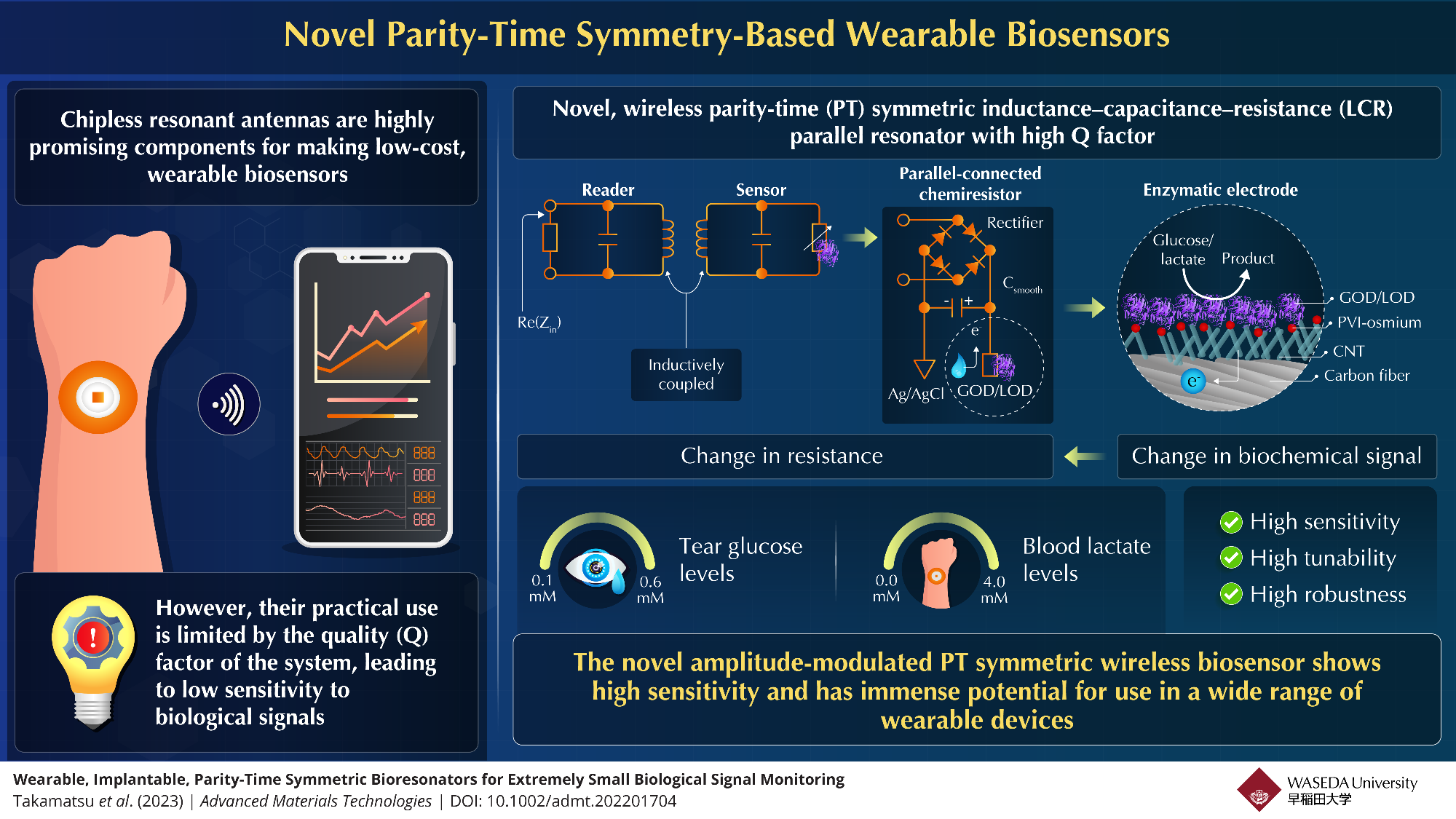
Researchers have developed a novel, wireless, PT-symmetric wearable resonator that can detect tear glucose and blood lactate levels in the micromolar range. The resonator is composed of an inductance–capacitance–resistance (LCR) reader and an LCR sensor with an enzyme-based chemiresistor. The setup has a high quality (Q) factor, making it highly sensitive. Image Credit: Professor Takeo Miyake from Waseda University
However, scientists from Japan have recently come up with a wireless, novel, parity-time symmetry-based bio resonator that has the potential to detect minute concentrations of blood lactate and tear glucose. This tunable, highly sensitive bioresonator has the potential to revolutionize personalized health tracking and digitized healthcare systems.
Wireless wearable biosensors have been a turning point in personalized health monitoring and healthcare digitization since they can effectively detect, record, and track medically considerable biological signals.
Chipless resonant antennae are known to be highly promising components of wearable biosensors, as they are tractable and affordable. Yet, their practical applications are limited by low sensitivity (incompetence to detect small biological signals) as a result of the low quality (Q) factor of the system.
To overcome this limitation, scientists headed by Professor Takeo Miyake from Waseda University, Professor Yin Sijie from Beijing Institute of Technology, and Taiki Takamatsu from Japan Aerospace Exploration Agency have come up with a wireless bioresonator using “parity-time (PT) symmetry” that can detect minute biological signals.
Their study has been reported in the Advanced Materials Technologies journal.
In this study, the researchers created a bioresonator that consists of a magnetically coupled reader and sensor with a high Q factor, and thus, increased sensitivity to biochemical changes. The sensor and reader both include an inductor (L) and capacitor (C) that are known to be parallel-connected to a resistor (R).
In the sensor, the resistor is a chemical sensor called a “chemiresistor” that converts biochemical signals into changes in resistance. The chemiresistor contains an enzymatic electrode with an immobilized enzyme.
Minute biochemical changes at the enzymatic electrode (in response to changes in the levels of biomolecules such as blood sugar or lactate) are therefore converted into electrical signals by the sensor and then amplified at the reader.
We modeled the characteristics of the PT-symmetric wireless sensing system by using an eigenvalue solution and input impedance, and experimentally demonstrated the sensitivity enhancement at/near the exceptional point by using parallel inductance–capacitance–resistance (LCR) resonators.
Takeo Miyake, Professor, Waseda University
Miyake added, “The developed amplitude modulation-based PT-symmetric bioresonator can detect small biological signals that have been difficult to measure wirelessly until now. Moreover, our PT-symmetric system provides two types of readout modes: threshold-based switching and enhanced linear detection. Different readout modes can be used for different sensing ranges.”
The system was tested by the scientists (in this context, comprising a glucose-specific enzyme) on human tear fluids. The team discovered that it was capable of detecting glucose concentrations in the range of 0.1 to 0.6 mM.
They also tested it with a lactate-specific enzyme and commercially available human skin and discovered that it could quantify lactate levels in the range of 0.0 to 4.0 mM through human skin tissue without any loss of sensitivity.
This result further suggests that the biosensor is suitable for use as an implantable device.
In comparison to conventional chipless resonant antenna-based systems, the PT-symmetric system demonstrated a 2000-fold increase in sensitivity for linear detection and a 78% relative improvement in threshold-based detection.
The present telemetry system is robust and tunable. It can enhance the sensitivity of sensors to small biological signals. We envision that this technology can be used for developing smart contact lenses to detect tear glucose and/or implantable medical devices to detect lactate for efficient monitoring of diabetes and blood poisoning.
Takeo Miyake, Professor, Waseda University
This innovative PT-symmetric wireless wearable bioresonator has the potential to revolutionize personalized health monitoring and usher in a new era of efficient, digitized healthcare systems.
Journal Reference:
Takamatsu, T., et al. (2023) Wearable, Implantable, Parity-Time Symmetric Bioresonators for Extremely Small Biological Signal Monitoring. Advanced Materials Technologies. https://doi.org/10.1002/admt.202201704